Hurricane Katrina: Analysis and Recommendations
VerifiedAdded on 2023/01/10
|10
|3008
|92
AI Summary
This report analyzes the impact of Hurricane Katrina in the USA, focusing on key environmental, social, and public health issues. It provides recommendations for future preparedness and response.
Contribute Materials
Your contribution can guide someone’s learning journey. Share your
documents today.
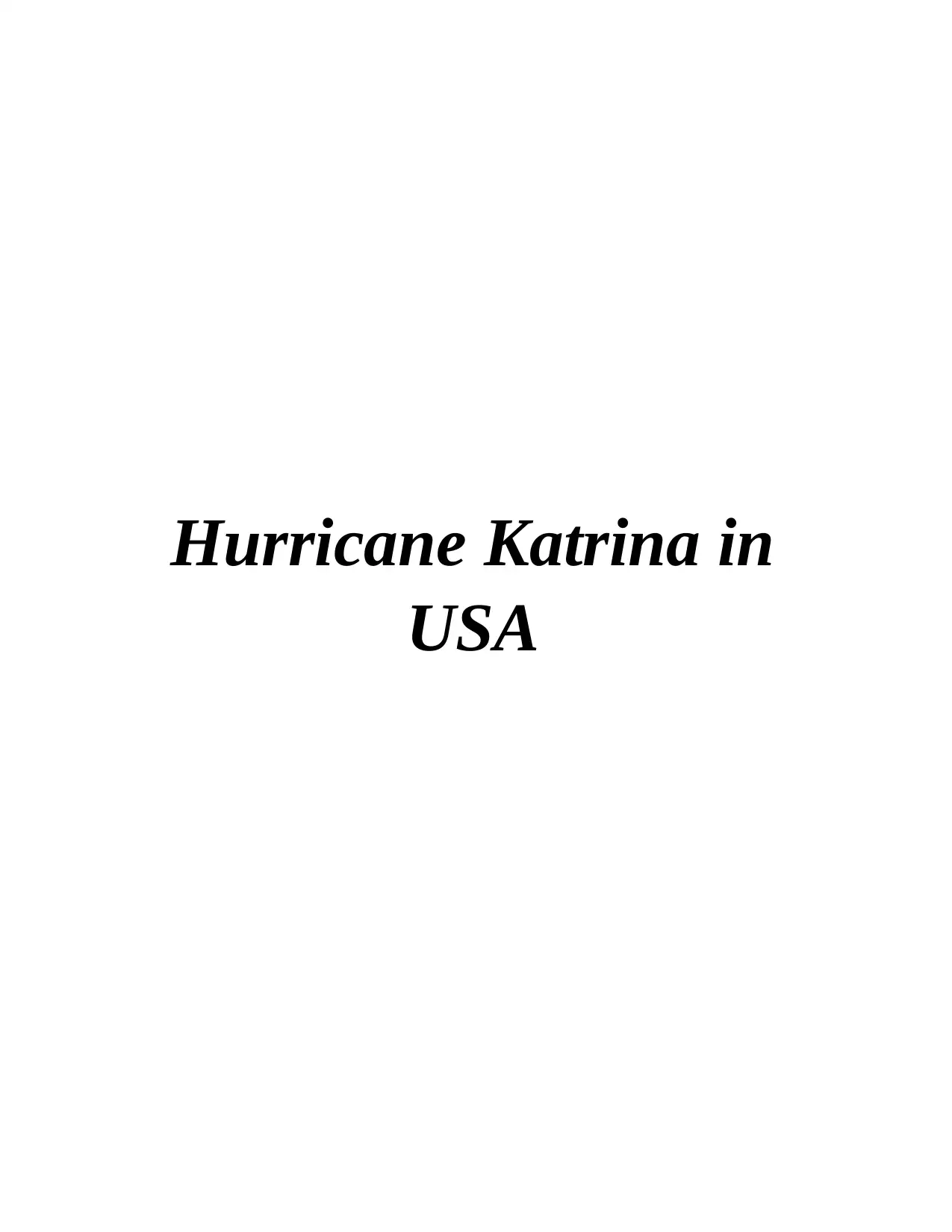
Hurricane Katrina in
USA
USA
Secure Best Marks with AI Grader
Need help grading? Try our AI Grader for instant feedback on your assignments.
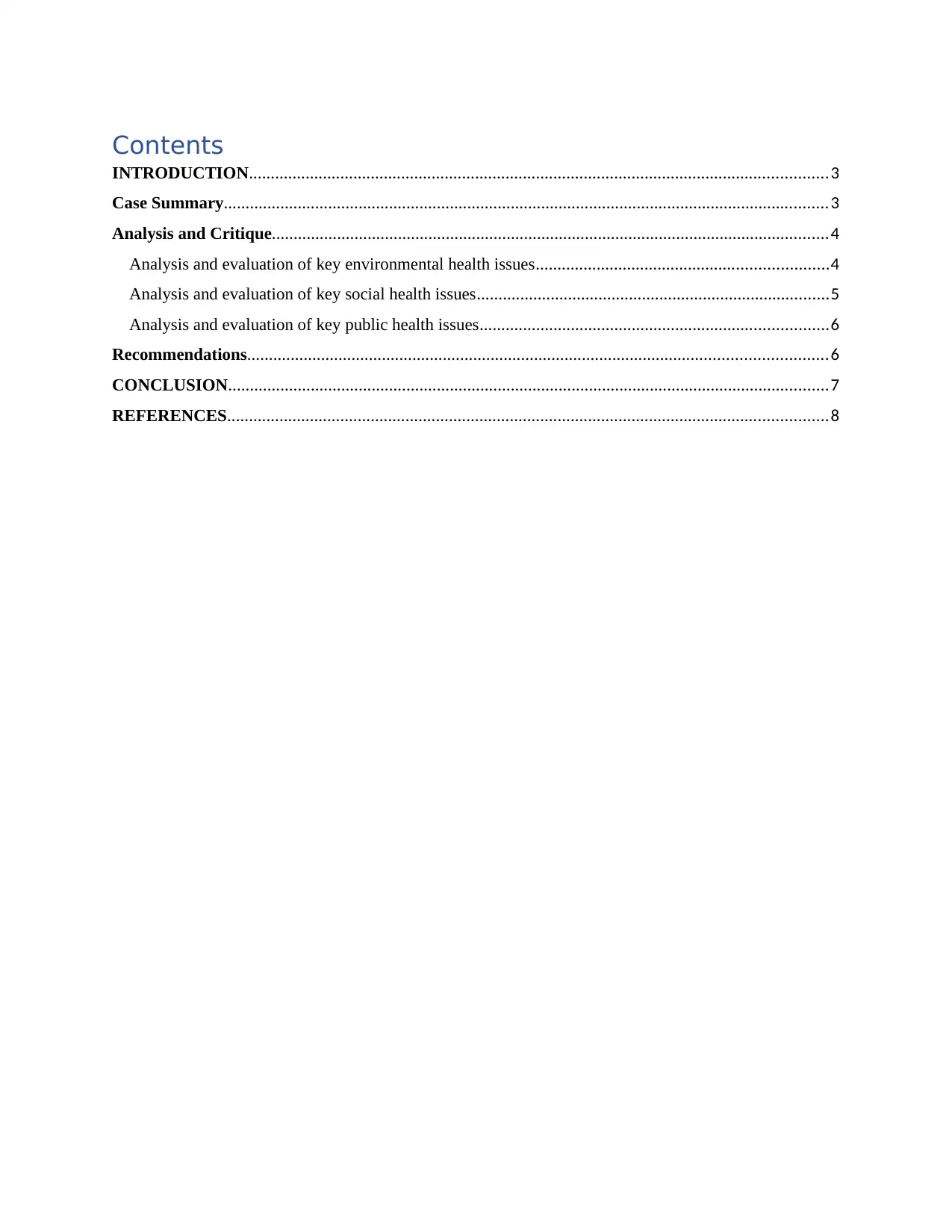
Contents
INTRODUCTION.....................................................................................................................................3
Case Summary...........................................................................................................................................3
Analysis and Critique................................................................................................................................4
Analysis and evaluation of key environmental health issues...................................................................4
Analysis and evaluation of key social health issues.................................................................................5
Analysis and evaluation of key public health issues................................................................................6
Recommendations.....................................................................................................................................6
CONCLUSION..........................................................................................................................................7
REFERENCES..........................................................................................................................................8
INTRODUCTION.....................................................................................................................................3
Case Summary...........................................................................................................................................3
Analysis and Critique................................................................................................................................4
Analysis and evaluation of key environmental health issues...................................................................4
Analysis and evaluation of key social health issues.................................................................................5
Analysis and evaluation of key public health issues................................................................................6
Recommendations.....................................................................................................................................6
CONCLUSION..........................................................................................................................................7
REFERENCES..........................................................................................................................................8
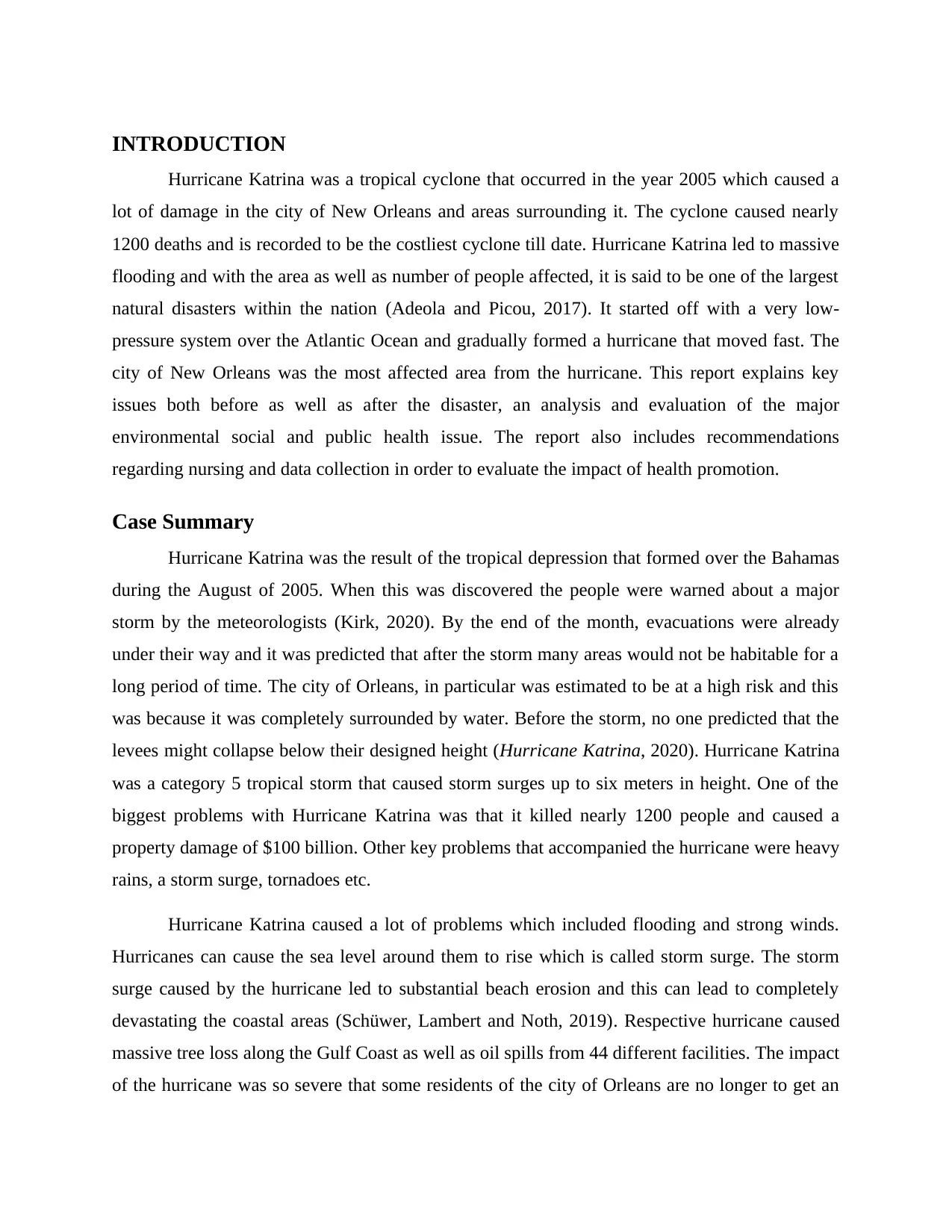
INTRODUCTION
Hurricane Katrina was a tropical cyclone that occurred in the year 2005 which caused a
lot of damage in the city of New Orleans and areas surrounding it. The cyclone caused nearly
1200 deaths and is recorded to be the costliest cyclone till date. Hurricane Katrina led to massive
flooding and with the area as well as number of people affected, it is said to be one of the largest
natural disasters within the nation (Adeola and Picou, 2017). It started off with a very low-
pressure system over the Atlantic Ocean and gradually formed a hurricane that moved fast. The
city of New Orleans was the most affected area from the hurricane. This report explains key
issues both before as well as after the disaster, an analysis and evaluation of the major
environmental social and public health issue. The report also includes recommendations
regarding nursing and data collection in order to evaluate the impact of health promotion.
Case Summary
Hurricane Katrina was the result of the tropical depression that formed over the Bahamas
during the August of 2005. When this was discovered the people were warned about a major
storm by the meteorologists (Kirk, 2020). By the end of the month, evacuations were already
under their way and it was predicted that after the storm many areas would not be habitable for a
long period of time. The city of Orleans, in particular was estimated to be at a high risk and this
was because it was completely surrounded by water. Before the storm, no one predicted that the
levees might collapse below their designed height (Hurricane Katrina, 2020). Hurricane Katrina
was a category 5 tropical storm that caused storm surges up to six meters in height. One of the
biggest problems with Hurricane Katrina was that it killed nearly 1200 people and caused a
property damage of $100 billion. Other key problems that accompanied the hurricane were heavy
rains, a storm surge, tornadoes etc.
Hurricane Katrina caused a lot of problems which included flooding and strong winds.
Hurricanes can cause the sea level around them to rise which is called storm surge. The storm
surge caused by the hurricane led to substantial beach erosion and this can lead to completely
devastating the coastal areas (Schüwer, Lambert and Noth, 2019). Respective hurricane caused
massive tree loss along the Gulf Coast as well as oil spills from 44 different facilities. The impact
of the hurricane was so severe that some residents of the city of Orleans are no longer to get an
Hurricane Katrina was a tropical cyclone that occurred in the year 2005 which caused a
lot of damage in the city of New Orleans and areas surrounding it. The cyclone caused nearly
1200 deaths and is recorded to be the costliest cyclone till date. Hurricane Katrina led to massive
flooding and with the area as well as number of people affected, it is said to be one of the largest
natural disasters within the nation (Adeola and Picou, 2017). It started off with a very low-
pressure system over the Atlantic Ocean and gradually formed a hurricane that moved fast. The
city of New Orleans was the most affected area from the hurricane. This report explains key
issues both before as well as after the disaster, an analysis and evaluation of the major
environmental social and public health issue. The report also includes recommendations
regarding nursing and data collection in order to evaluate the impact of health promotion.
Case Summary
Hurricane Katrina was the result of the tropical depression that formed over the Bahamas
during the August of 2005. When this was discovered the people were warned about a major
storm by the meteorologists (Kirk, 2020). By the end of the month, evacuations were already
under their way and it was predicted that after the storm many areas would not be habitable for a
long period of time. The city of Orleans, in particular was estimated to be at a high risk and this
was because it was completely surrounded by water. Before the storm, no one predicted that the
levees might collapse below their designed height (Hurricane Katrina, 2020). Hurricane Katrina
was a category 5 tropical storm that caused storm surges up to six meters in height. One of the
biggest problems with Hurricane Katrina was that it killed nearly 1200 people and caused a
property damage of $100 billion. Other key problems that accompanied the hurricane were heavy
rains, a storm surge, tornadoes etc.
Hurricane Katrina caused a lot of problems which included flooding and strong winds.
Hurricanes can cause the sea level around them to rise which is called storm surge. The storm
surge caused by the hurricane led to substantial beach erosion and this can lead to completely
devastating the coastal areas (Schüwer, Lambert and Noth, 2019). Respective hurricane caused
massive tree loss along the Gulf Coast as well as oil spills from 44 different facilities. The impact
of the hurricane was so severe that some residents of the city of Orleans are no longer to get an

insurance for their home in order to cover the impact that was cause by the same. Besides the
city of Orleans, Gulf Coast of Mississippi also suffered an extremely severe damage from the
hurricane. During the pre- and post-storm evacuation, special need shelters for people with
medical needs were set up. Many people who got affected by the climate change, have not been
able to move back to their homes. The hurricane had caused so much damage that led levees to
fail which further caused large amounts of water to release.
By analyzing the above case, it is recommended that if a similar hurricane strikes again,
higher and more resistant levees as well as flood walls should be constructed. This is because it
will help in eliminating their risk of collapsing (Basker and Miranda, 2018). Canal closures,
emergency pumps should be installed at the ends of the canals and they should be designed in
such a way that they help in reducing overall heights of the flood. Hurricane Katrina is said to be
one of the deadliest cyclones that the US has seen in the history. It not only caused harm to the
lives of people and their homes, but the environment as well (Olshansky and Johnson, 2017).
Although a lot of people were evacuated when the warning came out, the government was still
heavily criticized for the way it handled the disaster and an inadequate response. As of today,
705 people are still missing as a result of the hurricane who have not been found. And the people
who had been found that time, were kept as refugees safely.
Analysis and Critique
Analysis and evaluation of key environmental health issues
There are various environmental health issues in the areas that were affected by
Hurricane Katrina, specifically in the city of New Orleans (Seltzer and Nobles, 2017). In order to
address these issues, a multidisciplinary team consisting both state as well as federal agencies
was formed. The key environmental health issues are explained below –
Safe food – The supply of food items in both retail as well as wholesale establishments
were inspected and certified. Apart from this, the handling as well as disposal of contaminated or
spoiled products were monitored (Clay and et. al., 2018). Also, the safety of commercial food
harvest was ensured.
city of Orleans, Gulf Coast of Mississippi also suffered an extremely severe damage from the
hurricane. During the pre- and post-storm evacuation, special need shelters for people with
medical needs were set up. Many people who got affected by the climate change, have not been
able to move back to their homes. The hurricane had caused so much damage that led levees to
fail which further caused large amounts of water to release.
By analyzing the above case, it is recommended that if a similar hurricane strikes again,
higher and more resistant levees as well as flood walls should be constructed. This is because it
will help in eliminating their risk of collapsing (Basker and Miranda, 2018). Canal closures,
emergency pumps should be installed at the ends of the canals and they should be designed in
such a way that they help in reducing overall heights of the flood. Hurricane Katrina is said to be
one of the deadliest cyclones that the US has seen in the history. It not only caused harm to the
lives of people and their homes, but the environment as well (Olshansky and Johnson, 2017).
Although a lot of people were evacuated when the warning came out, the government was still
heavily criticized for the way it handled the disaster and an inadequate response. As of today,
705 people are still missing as a result of the hurricane who have not been found. And the people
who had been found that time, were kept as refugees safely.
Analysis and Critique
Analysis and evaluation of key environmental health issues
There are various environmental health issues in the areas that were affected by
Hurricane Katrina, specifically in the city of New Orleans (Seltzer and Nobles, 2017). In order to
address these issues, a multidisciplinary team consisting both state as well as federal agencies
was formed. The key environmental health issues are explained below –
Safe food – The supply of food items in both retail as well as wholesale establishments
were inspected and certified. Apart from this, the handling as well as disposal of contaminated or
spoiled products were monitored (Clay and et. al., 2018). Also, the safety of commercial food
harvest was ensured.
Secure Best Marks with AI Grader
Need help grading? Try our AI Grader for instant feedback on your assignments.
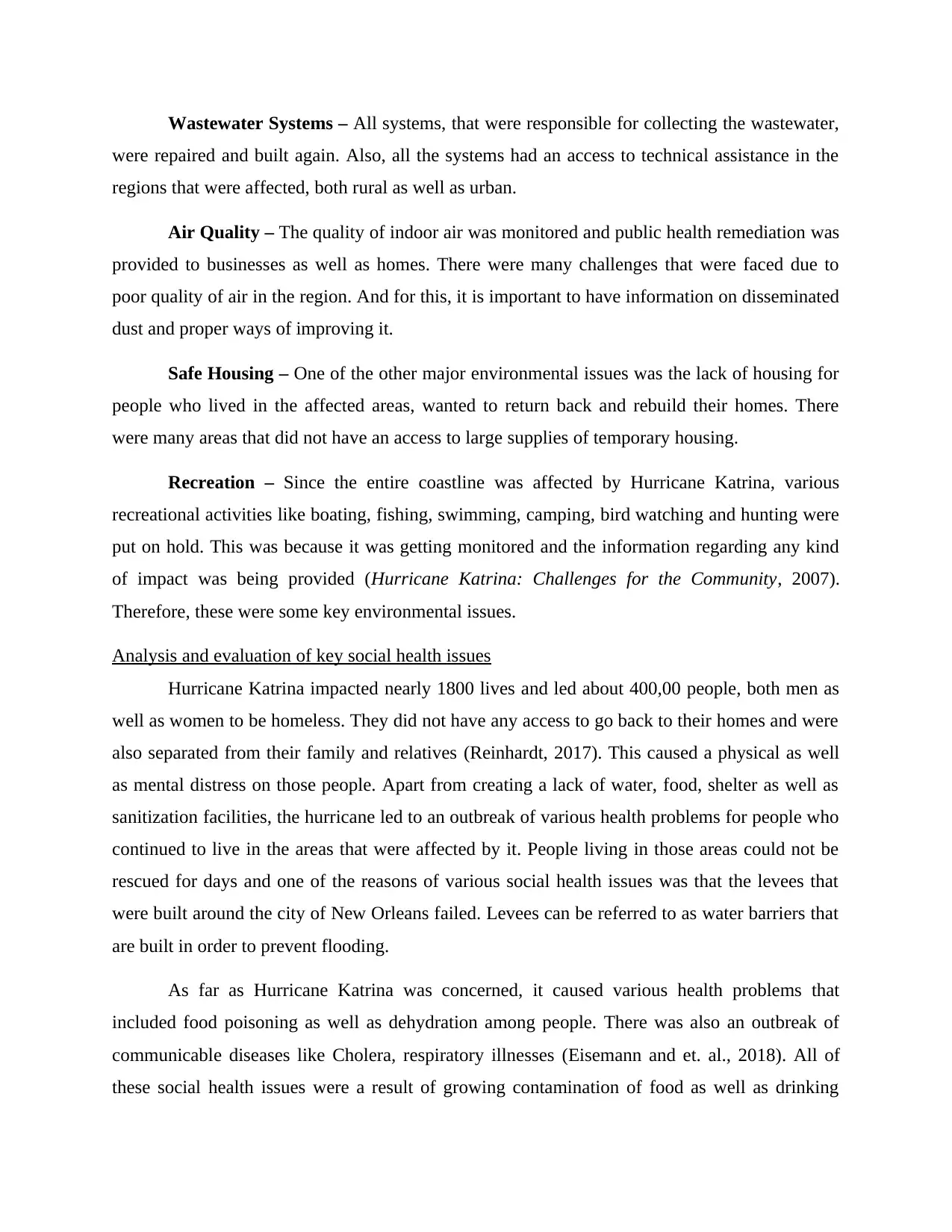
Wastewater Systems – All systems, that were responsible for collecting the wastewater,
were repaired and built again. Also, all the systems had an access to technical assistance in the
regions that were affected, both rural as well as urban.
Air Quality – The quality of indoor air was monitored and public health remediation was
provided to businesses as well as homes. There were many challenges that were faced due to
poor quality of air in the region. And for this, it is important to have information on disseminated
dust and proper ways of improving it.
Safe Housing – One of the other major environmental issues was the lack of housing for
people who lived in the affected areas, wanted to return back and rebuild their homes. There
were many areas that did not have an access to large supplies of temporary housing.
Recreation – Since the entire coastline was affected by Hurricane Katrina, various
recreational activities like boating, fishing, swimming, camping, bird watching and hunting were
put on hold. This was because it was getting monitored and the information regarding any kind
of impact was being provided (Hurricane Katrina: Challenges for the Community, 2007).
Therefore, these were some key environmental issues.
Analysis and evaluation of key social health issues
Hurricane Katrina impacted nearly 1800 lives and led about 400,00 people, both men as
well as women to be homeless. They did not have any access to go back to their homes and were
also separated from their family and relatives (Reinhardt, 2017). This caused a physical as well
as mental distress on those people. Apart from creating a lack of water, food, shelter as well as
sanitization facilities, the hurricane led to an outbreak of various health problems for people who
continued to live in the areas that were affected by it. People living in those areas could not be
rescued for days and one of the reasons of various social health issues was that the levees that
were built around the city of New Orleans failed. Levees can be referred to as water barriers that
are built in order to prevent flooding.
As far as Hurricane Katrina was concerned, it caused various health problems that
included food poisoning as well as dehydration among people. There was also an outbreak of
communicable diseases like Cholera, respiratory illnesses (Eisemann and et. al., 2018). All of
these social health issues were a result of growing contamination of food as well as drinking
were repaired and built again. Also, all the systems had an access to technical assistance in the
regions that were affected, both rural as well as urban.
Air Quality – The quality of indoor air was monitored and public health remediation was
provided to businesses as well as homes. There were many challenges that were faced due to
poor quality of air in the region. And for this, it is important to have information on disseminated
dust and proper ways of improving it.
Safe Housing – One of the other major environmental issues was the lack of housing for
people who lived in the affected areas, wanted to return back and rebuild their homes. There
were many areas that did not have an access to large supplies of temporary housing.
Recreation – Since the entire coastline was affected by Hurricane Katrina, various
recreational activities like boating, fishing, swimming, camping, bird watching and hunting were
put on hold. This was because it was getting monitored and the information regarding any kind
of impact was being provided (Hurricane Katrina: Challenges for the Community, 2007).
Therefore, these were some key environmental issues.
Analysis and evaluation of key social health issues
Hurricane Katrina impacted nearly 1800 lives and led about 400,00 people, both men as
well as women to be homeless. They did not have any access to go back to their homes and were
also separated from their family and relatives (Reinhardt, 2017). This caused a physical as well
as mental distress on those people. Apart from creating a lack of water, food, shelter as well as
sanitization facilities, the hurricane led to an outbreak of various health problems for people who
continued to live in the areas that were affected by it. People living in those areas could not be
rescued for days and one of the reasons of various social health issues was that the levees that
were built around the city of New Orleans failed. Levees can be referred to as water barriers that
are built in order to prevent flooding.
As far as Hurricane Katrina was concerned, it caused various health problems that
included food poisoning as well as dehydration among people. There was also an outbreak of
communicable diseases like Cholera, respiratory illnesses (Eisemann and et. al., 2018). All of
these social health issues were a result of growing contamination of food as well as drinking
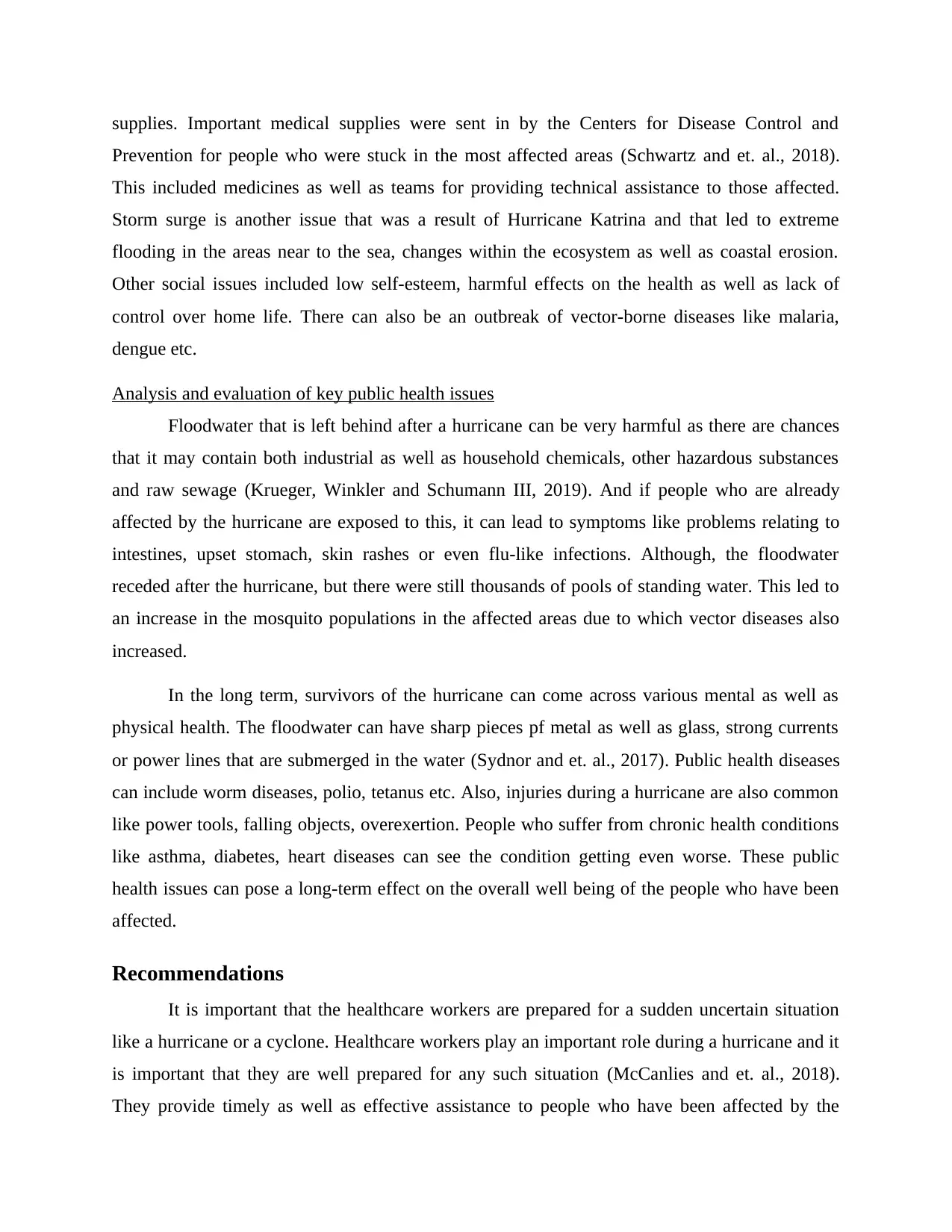
supplies. Important medical supplies were sent in by the Centers for Disease Control and
Prevention for people who were stuck in the most affected areas (Schwartz and et. al., 2018).
This included medicines as well as teams for providing technical assistance to those affected.
Storm surge is another issue that was a result of Hurricane Katrina and that led to extreme
flooding in the areas near to the sea, changes within the ecosystem as well as coastal erosion.
Other social issues included low self-esteem, harmful effects on the health as well as lack of
control over home life. There can also be an outbreak of vector-borne diseases like malaria,
dengue etc.
Analysis and evaluation of key public health issues
Floodwater that is left behind after a hurricane can be very harmful as there are chances
that it may contain both industrial as well as household chemicals, other hazardous substances
and raw sewage (Krueger, Winkler and Schumann III, 2019). And if people who are already
affected by the hurricane are exposed to this, it can lead to symptoms like problems relating to
intestines, upset stomach, skin rashes or even flu-like infections. Although, the floodwater
receded after the hurricane, but there were still thousands of pools of standing water. This led to
an increase in the mosquito populations in the affected areas due to which vector diseases also
increased.
In the long term, survivors of the hurricane can come across various mental as well as
physical health. The floodwater can have sharp pieces pf metal as well as glass, strong currents
or power lines that are submerged in the water (Sydnor and et. al., 2017). Public health diseases
can include worm diseases, polio, tetanus etc. Also, injuries during a hurricane are also common
like power tools, falling objects, overexertion. People who suffer from chronic health conditions
like asthma, diabetes, heart diseases can see the condition getting even worse. These public
health issues can pose a long-term effect on the overall well being of the people who have been
affected.
Recommendations
It is important that the healthcare workers are prepared for a sudden uncertain situation
like a hurricane or a cyclone. Healthcare workers play an important role during a hurricane and it
is important that they are well prepared for any such situation (McCanlies and et. al., 2018).
They provide timely as well as effective assistance to people who have been affected by the
Prevention for people who were stuck in the most affected areas (Schwartz and et. al., 2018).
This included medicines as well as teams for providing technical assistance to those affected.
Storm surge is another issue that was a result of Hurricane Katrina and that led to extreme
flooding in the areas near to the sea, changes within the ecosystem as well as coastal erosion.
Other social issues included low self-esteem, harmful effects on the health as well as lack of
control over home life. There can also be an outbreak of vector-borne diseases like malaria,
dengue etc.
Analysis and evaluation of key public health issues
Floodwater that is left behind after a hurricane can be very harmful as there are chances
that it may contain both industrial as well as household chemicals, other hazardous substances
and raw sewage (Krueger, Winkler and Schumann III, 2019). And if people who are already
affected by the hurricane are exposed to this, it can lead to symptoms like problems relating to
intestines, upset stomach, skin rashes or even flu-like infections. Although, the floodwater
receded after the hurricane, but there were still thousands of pools of standing water. This led to
an increase in the mosquito populations in the affected areas due to which vector diseases also
increased.
In the long term, survivors of the hurricane can come across various mental as well as
physical health. The floodwater can have sharp pieces pf metal as well as glass, strong currents
or power lines that are submerged in the water (Sydnor and et. al., 2017). Public health diseases
can include worm diseases, polio, tetanus etc. Also, injuries during a hurricane are also common
like power tools, falling objects, overexertion. People who suffer from chronic health conditions
like asthma, diabetes, heart diseases can see the condition getting even worse. These public
health issues can pose a long-term effect on the overall well being of the people who have been
affected.
Recommendations
It is important that the healthcare workers are prepared for a sudden uncertain situation
like a hurricane or a cyclone. Healthcare workers play an important role during a hurricane and it
is important that they are well prepared for any such situation (McCanlies and et. al., 2018).
They provide timely as well as effective assistance to people who have been affected by the

disaster. It is recommended that the healthcare workers should always be well equipped with all
the equipment as well as safety measures that will be required to help the victims. It is also
recommended that they should be provided with effective training as to how to deal with sudden
natural disasters. This will help them in providing care services in the most efficient way. This
can include assessment collaboration, priority setting, acute care needs etc.
It should be made sure that that all the healthcare settings have an access to advance
connections so that after the hurricane they can communicate with each other effectively. It is
recommended that the healthcare institutions should explore different innovative options so that
they ca help the patients in a much more advanced manner. This is because there are many
companies today that develop soft wares which use latest technologies and can prove out to be of
immense help after the hurricane has passed. Telehealth services should be used in order to
provide healthcare services to the people who are affected by the disaster (Stephens, 2019). Also,
consequences should be mitigated and this can be done by preparing the medical facilities
effectively. Doctors and nurses should be available in the emergency and to understand the state
of the patient as well as the impact of hurricane.
One of the other lessons that have been learnt from Hurricane Katrina is that it is always
important to have an evacuation plan. This is because the hospitals in the city of New Orleans
were left with very less staff when the hurricane had passed. And due to this, the people who
were being admitted were not being attended completely and in an effective manner because the
doctors as well as nurses were busy attending other people (Mielke, Gonzales and Powell, 2017).
Also, hospitals in the affected areas were not prepared to deal with such a big disaster, therefore,
it is recommended that they always have emergency plans and are well rehearsed with the same.
This is because it will help in carrying out the healthcare practices effectively.
CONCLUSION
From the above report, it can be concluded that Hurricane Katrina was one of the costliest
as well as strongest hurricane in the history of the United States. It caused a lot of damage and
also was the reason for outbreak of many public as well as social health issues. Not only this, it
also impacted the environment in an adverse manner. The hurricane occurred during the August
of 2005 and proved out to be extremely destructive. The city of New Orleans was one of the
most affected areas from the hurricane and this was because it lies below the sea level. Apart
the equipment as well as safety measures that will be required to help the victims. It is also
recommended that they should be provided with effective training as to how to deal with sudden
natural disasters. This will help them in providing care services in the most efficient way. This
can include assessment collaboration, priority setting, acute care needs etc.
It should be made sure that that all the healthcare settings have an access to advance
connections so that after the hurricane they can communicate with each other effectively. It is
recommended that the healthcare institutions should explore different innovative options so that
they ca help the patients in a much more advanced manner. This is because there are many
companies today that develop soft wares which use latest technologies and can prove out to be of
immense help after the hurricane has passed. Telehealth services should be used in order to
provide healthcare services to the people who are affected by the disaster (Stephens, 2019). Also,
consequences should be mitigated and this can be done by preparing the medical facilities
effectively. Doctors and nurses should be available in the emergency and to understand the state
of the patient as well as the impact of hurricane.
One of the other lessons that have been learnt from Hurricane Katrina is that it is always
important to have an evacuation plan. This is because the hospitals in the city of New Orleans
were left with very less staff when the hurricane had passed. And due to this, the people who
were being admitted were not being attended completely and in an effective manner because the
doctors as well as nurses were busy attending other people (Mielke, Gonzales and Powell, 2017).
Also, hospitals in the affected areas were not prepared to deal with such a big disaster, therefore,
it is recommended that they always have emergency plans and are well rehearsed with the same.
This is because it will help in carrying out the healthcare practices effectively.
CONCLUSION
From the above report, it can be concluded that Hurricane Katrina was one of the costliest
as well as strongest hurricane in the history of the United States. It caused a lot of damage and
also was the reason for outbreak of many public as well as social health issues. Not only this, it
also impacted the environment in an adverse manner. The hurricane occurred during the August
of 2005 and proved out to be extremely destructive. The city of New Orleans was one of the
most affected areas from the hurricane and this was because it lies below the sea level. Apart
Paraphrase This Document
Need a fresh take? Get an instant paraphrase of this document with our AI Paraphraser

from all this, the hurricane also caused a storm surge which led to beach erosion. A massive tree
loss was also the result of the same and there are any people till now who have not been able to
get home insurance so as to cover the impact that was caused from the impact of Hurricane
Katrina.
loss was also the result of the same and there are any people till now who have not been able to
get home insurance so as to cover the impact that was caused from the impact of Hurricane
Katrina.
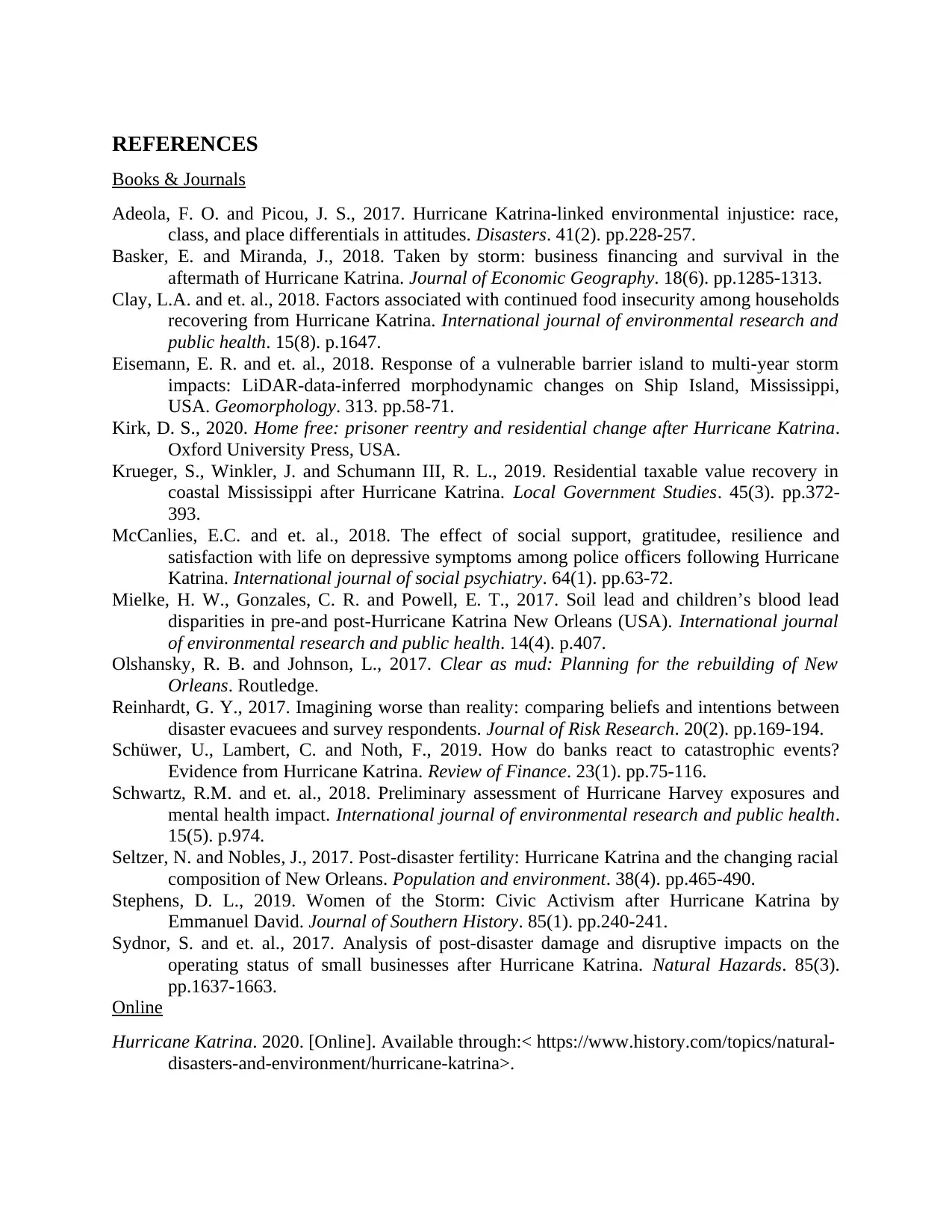
REFERENCES
Books & Journals
Adeola, F. O. and Picou, J. S., 2017. Hurricane Katrina‐linked environmental injustice: race,
class, and place differentials in attitudes. Disasters. 41(2). pp.228-257.
Basker, E. and Miranda, J., 2018. Taken by storm: business financing and survival in the
aftermath of Hurricane Katrina. Journal of Economic Geography. 18(6). pp.1285-1313.
Clay, L.A. and et. al., 2018. Factors associated with continued food insecurity among households
recovering from Hurricane Katrina. International journal of environmental research and
public health. 15(8). p.1647.
Eisemann, E. R. and et. al., 2018. Response of a vulnerable barrier island to multi-year storm
impacts: LiDAR-data-inferred morphodynamic changes on Ship Island, Mississippi,
USA. Geomorphology. 313. pp.58-71.
Kirk, D. S., 2020. Home free: prisoner reentry and residential change after Hurricane Katrina.
Oxford University Press, USA.
Krueger, S., Winkler, J. and Schumann III, R. L., 2019. Residential taxable value recovery in
coastal Mississippi after Hurricane Katrina. Local Government Studies. 45(3). pp.372-
393.
McCanlies, E.C. and et. al., 2018. The effect of social support, gratitudee, resilience and
satisfaction with life on depressive symptoms among police officers following Hurricane
Katrina. International journal of social psychiatry. 64(1). pp.63-72.
Mielke, H. W., Gonzales, C. R. and Powell, E. T., 2017. Soil lead and children’s blood lead
disparities in pre-and post-Hurricane Katrina New Orleans (USA). International journal
of environmental research and public health. 14(4). p.407.
Olshansky, R. B. and Johnson, L., 2017. Clear as mud: Planning for the rebuilding of New
Orleans. Routledge.
Reinhardt, G. Y., 2017. Imagining worse than reality: comparing beliefs and intentions between
disaster evacuees and survey respondents. Journal of Risk Research. 20(2). pp.169-194.
Schüwer, U., Lambert, C. and Noth, F., 2019. How do banks react to catastrophic events?
Evidence from Hurricane Katrina. Review of Finance. 23(1). pp.75-116.
Schwartz, R.M. and et. al., 2018. Preliminary assessment of Hurricane Harvey exposures and
mental health impact. International journal of environmental research and public health.
15(5). p.974.
Seltzer, N. and Nobles, J., 2017. Post-disaster fertility: Hurricane Katrina and the changing racial
composition of New Orleans. Population and environment. 38(4). pp.465-490.
Stephens, D. L., 2019. Women of the Storm: Civic Activism after Hurricane Katrina by
Emmanuel David. Journal of Southern History. 85(1). pp.240-241.
Sydnor, S. and et. al., 2017. Analysis of post-disaster damage and disruptive impacts on the
operating status of small businesses after Hurricane Katrina. Natural Hazards. 85(3).
pp.1637-1663.
Online
Hurricane Katrina. 2020. [Online]. Available through:< https://www.history.com/topics/natural-
disasters-and-environment/hurricane-katrina>.
Books & Journals
Adeola, F. O. and Picou, J. S., 2017. Hurricane Katrina‐linked environmental injustice: race,
class, and place differentials in attitudes. Disasters. 41(2). pp.228-257.
Basker, E. and Miranda, J., 2018. Taken by storm: business financing and survival in the
aftermath of Hurricane Katrina. Journal of Economic Geography. 18(6). pp.1285-1313.
Clay, L.A. and et. al., 2018. Factors associated with continued food insecurity among households
recovering from Hurricane Katrina. International journal of environmental research and
public health. 15(8). p.1647.
Eisemann, E. R. and et. al., 2018. Response of a vulnerable barrier island to multi-year storm
impacts: LiDAR-data-inferred morphodynamic changes on Ship Island, Mississippi,
USA. Geomorphology. 313. pp.58-71.
Kirk, D. S., 2020. Home free: prisoner reentry and residential change after Hurricane Katrina.
Oxford University Press, USA.
Krueger, S., Winkler, J. and Schumann III, R. L., 2019. Residential taxable value recovery in
coastal Mississippi after Hurricane Katrina. Local Government Studies. 45(3). pp.372-
393.
McCanlies, E.C. and et. al., 2018. The effect of social support, gratitudee, resilience and
satisfaction with life on depressive symptoms among police officers following Hurricane
Katrina. International journal of social psychiatry. 64(1). pp.63-72.
Mielke, H. W., Gonzales, C. R. and Powell, E. T., 2017. Soil lead and children’s blood lead
disparities in pre-and post-Hurricane Katrina New Orleans (USA). International journal
of environmental research and public health. 14(4). p.407.
Olshansky, R. B. and Johnson, L., 2017. Clear as mud: Planning for the rebuilding of New
Orleans. Routledge.
Reinhardt, G. Y., 2017. Imagining worse than reality: comparing beliefs and intentions between
disaster evacuees and survey respondents. Journal of Risk Research. 20(2). pp.169-194.
Schüwer, U., Lambert, C. and Noth, F., 2019. How do banks react to catastrophic events?
Evidence from Hurricane Katrina. Review of Finance. 23(1). pp.75-116.
Schwartz, R.M. and et. al., 2018. Preliminary assessment of Hurricane Harvey exposures and
mental health impact. International journal of environmental research and public health.
15(5). p.974.
Seltzer, N. and Nobles, J., 2017. Post-disaster fertility: Hurricane Katrina and the changing racial
composition of New Orleans. Population and environment. 38(4). pp.465-490.
Stephens, D. L., 2019. Women of the Storm: Civic Activism after Hurricane Katrina by
Emmanuel David. Journal of Southern History. 85(1). pp.240-241.
Sydnor, S. and et. al., 2017. Analysis of post-disaster damage and disruptive impacts on the
operating status of small businesses after Hurricane Katrina. Natural Hazards. 85(3).
pp.1637-1663.
Online
Hurricane Katrina. 2020. [Online]. Available through:< https://www.history.com/topics/natural-
disasters-and-environment/hurricane-katrina>.
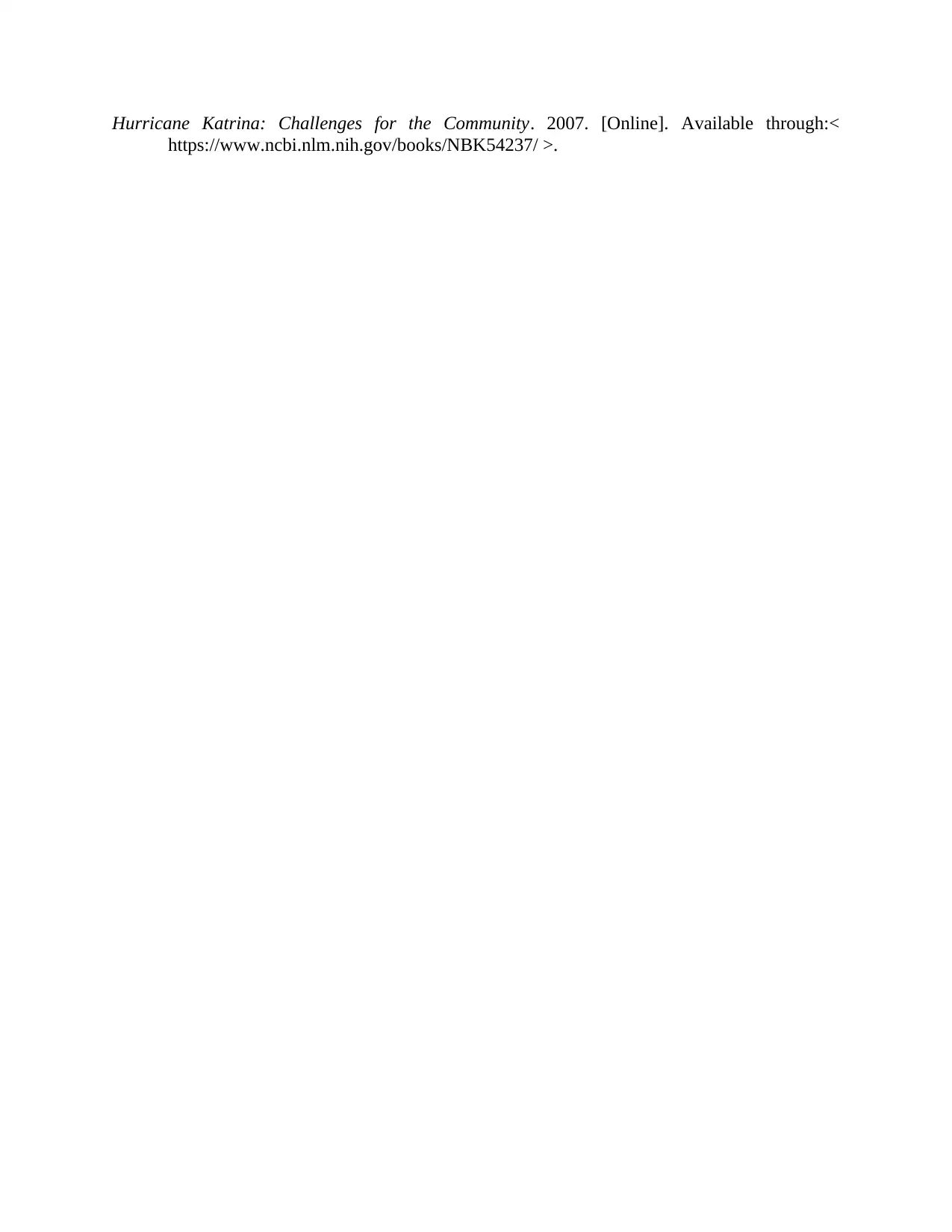
Hurricane Katrina: Challenges for the Community. 2007. [Online]. Available through:<
https://www.ncbi.nlm.nih.gov/books/NBK54237/ >.
https://www.ncbi.nlm.nih.gov/books/NBK54237/ >.
1 out of 10
Related Documents
Your All-in-One AI-Powered Toolkit for Academic Success.
+13062052269
info@desklib.com
Available 24*7 on WhatsApp / Email
![[object Object]](/_next/static/media/star-bottom.7253800d.svg)
Unlock your academic potential
© 2024 | Zucol Services PVT LTD | All rights reserved.





